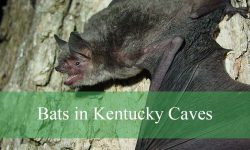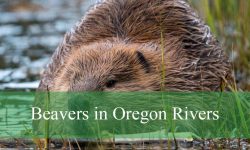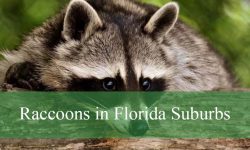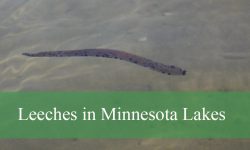Idaho is a great place to see many different types of birds throughout the year. From bright and colorful birds to large and powerful ones, the state offers something for every bird lover. This guide highlights 50 common birds in Idaho that you can easily spot.
Birds in Idaho live in many different environments like forests, wetlands, grasslands, and cities. Each bird has its own unique traits and habits that make watching them fun and interesting. Learning to identify these birds will improve your birdwatching adventures.
This article provides clear descriptions and pictures of 50 common birds in Idaho. Small songbirds and large raptors are included in this list to help you recognize the birds you see. Discover the amazing variety of birds in Idaho today!
Different Types of Birds in Idaho
Mountain Bluebird (Sialia currucoides)
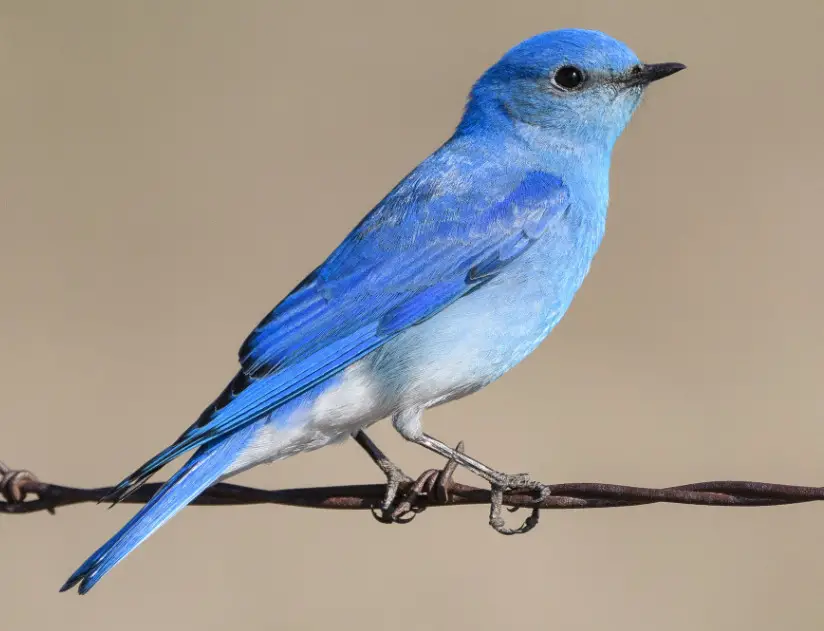
The Mountain Bluebird is a striking songbird recognized as the state bird of Idaho. Males are known for their brilliant sky-blue plumage, while females exhibit more subdued grayish-blue tones with hints of pale blue on the wings and tail. This species is slightly smaller than a robin, measuring about 6.3 to 7.9 inches in length, with slender bodies and a thin bill adapted for insect foraging.
Identifying the Mountain Bluebird is easiest during the breeding season when males perch on fence posts or branches in open fields, displaying their vivid coloration. Their call is a soft, warbling “cheer” or “few,” and their flight is buoyant and direct. These birds are cavity nesters, often using old woodpecker holes or man-made nest boxes placed in sagebrush or grassland regions.
In Idaho, Mountain Bluebirds are commonly found in open country such as prairies, pastures, and alpine meadows. They breed in higher elevations during spring and summer, often seen across southern and central parts of the state. As the seasons change, they may migrate to lower elevations or southern regions, but many remain in Idaho year-round if food sources are available.
American Robin (Turdus migratorius)
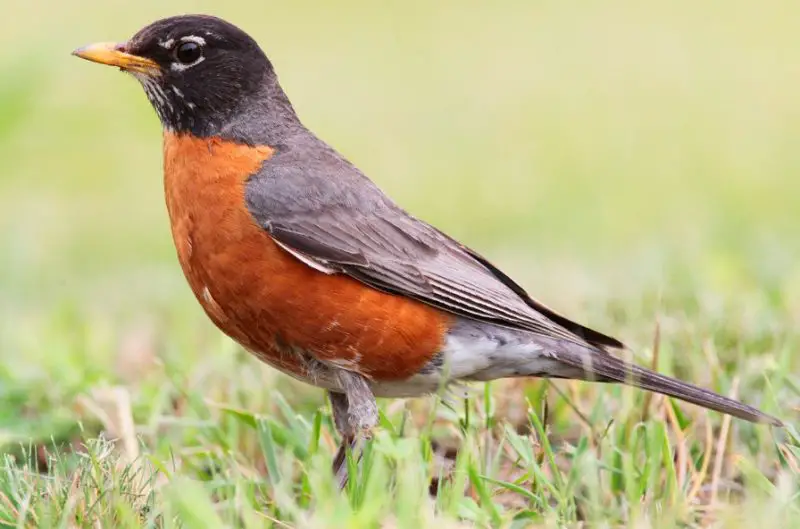
The American Robin is one of the most familiar and widespread birds in Idaho. Adults are easy to recognize with their rusty red breast, gray-brown back, and bold white eye ring. They are medium-sized songbirds, measuring about 9 to 11 inches long, with a robust body and strong yellow bill that helps them dig for worms.
These robins are often seen hopping across lawns, pulling earthworms from the ground with quick, precise movements. Their song is a melodious series of rich phrases, often one of the first bird calls heard at dawn. American Robins are also known for their cup-shaped nests made of mud and grass, typically built in trees, shrubs, or even on building ledges.
In Idaho, American Robins are year-round residents in many areas but are especially abundant in spring and summer. They are found in a wide range of habitats including forests, urban parks, gardens, and farmlands. Their adaptability makes them common across both lowland and mountainous regions of the state.
Black-capped Chickadee (Poecile atricapillus)

The Black-capped Chickadee is a small, energetic bird with a distinctive appearance. It has a black cap and bib, white cheeks, and soft gray feathers on the back with lighter underparts. This tiny bird measures about 4.7 to 5.9 inches in length, with a short neck and large head that give it a distinctive, round-bodied look.
Known for their curious and bold behavior, chickadees frequently approach humans and are common at backyard feeders, where they pick up seeds one at a time to eat elsewhere. Their familiar “chick-a-dee-dee-dee” call and whistled “fee-bee” song make them easy to recognize by sound. They also cache food in bark crevices for later use during colder months.
In Idaho, Black-capped Chickadees are year-round residents in woodlands, riparian forests, and suburban areas. They are most frequently found in the panhandle and mountainous regions where mixed deciduous and coniferous forests provide ideal shelter and foraging opportunities. Their presence brings liveliness to Idaho’s winter bird communities.
House Finch (Haemorhous mexicanus)
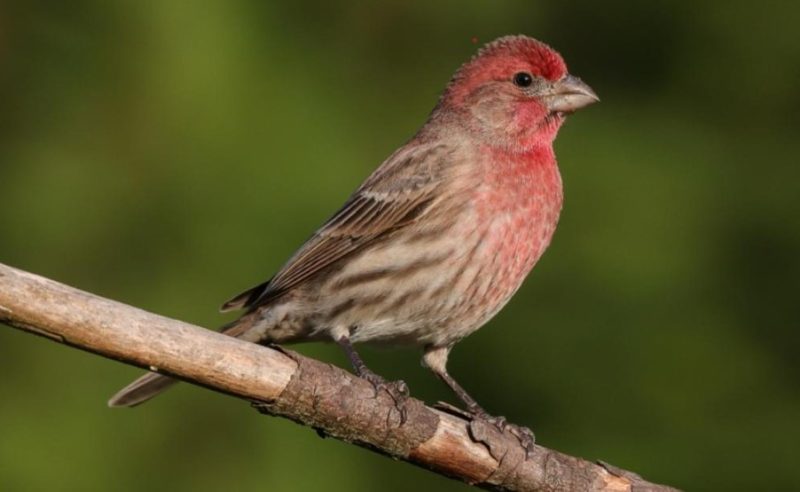
The House Finch is a small, sturdy songbird with a cheerful disposition. Males are easily recognized by their red forehead, breast, and rump, which contrast with their brown-streaked back and belly. Females lack the red coloring and are entirely streaked in shades of gray and brown. These birds measure about 5 to 6 inches long and have a slightly notched tail and a conical beak perfect for cracking seeds.
House Finches are social and often gather in noisy flocks. They sing a pleasant, warbling song and chirp frequently while feeding. These adaptable birds nest in a variety of locations, including building ledges, hanging planters, and natural tree cavities. They readily visit feeders, especially those stocked with sunflower or nyjer seeds.
In Idaho, House Finches are common throughout cities, towns, and farmlands, especially in the southern part of the state. They thrive in open areas with scattered trees and shrubs, as well as residential neighborhoods. Originally native to the Southwest, they have expanded their range significantly and are now one of Idaho’s most visible backyard birds.
European Starling (Sturnus vulgaris)

The European Starling is a medium-sized, stocky bird with iridescent black feathers that shimmer green and purple in sunlight. During winter, their plumage is speckled with white spots, and their yellow bill darkens to black. Starlings measure about 8 to 9 inches in length and have short tails and pointed wings that give them a triangular shape in flight.
Starlings are highly vocal, mimicking a variety of sounds, including other bird species and even mechanical noises. They are aggressive and gregarious, often forming large flocks that can displace native birds from nesting sites. Their flight is fast and direct, and they frequently forage in open fields or lawns for insects and grains.
In Idaho, European Starlings are found statewide and are present year-round. They inhabit urban and rural areas alike, nesting in buildings, trees, or nest boxes. As an introduced species, they have adapted remarkably well to human-altered environments, and their abundance has made them a prominent part of Idaho’s avifauna.
Cedar Waxwing (Bombycilla cedrorum)

The Cedar Waxwing is a sleek, elegant bird known for its silky plumage and distinctive appearance. Adults have a pale brown head and chest that fades into soft gray on the wings and tail, with a yellow band at the tip of the tail and a bold black mask across the face. Their namesake red wax-like tips on the wing feathers and crest atop the head give them a refined look. These birds measure about 6 to 7 inches long and have a short, square tail.
Cedar Waxwings are social and often found in flocks, moving together in search of fruit. They have a high-pitched, thin whistle that is often the first clue to their presence. These birds primarily eat berries, such as serviceberries and chokecherries, and are known for their gentle behavior, even passing berries to one another during courtship. In breeding season, they nest in shrubs or trees, often near water.
In Idaho, Cedar Waxwings can be found across the state, especially in areas with abundant fruit-bearing trees. They are most common in riparian zones, orchards, and suburban gardens during summer and fall. While many migrate, some may remain in southern Idaho year-round if food remains available through winter.
American Goldfinch (Spinus tristis)
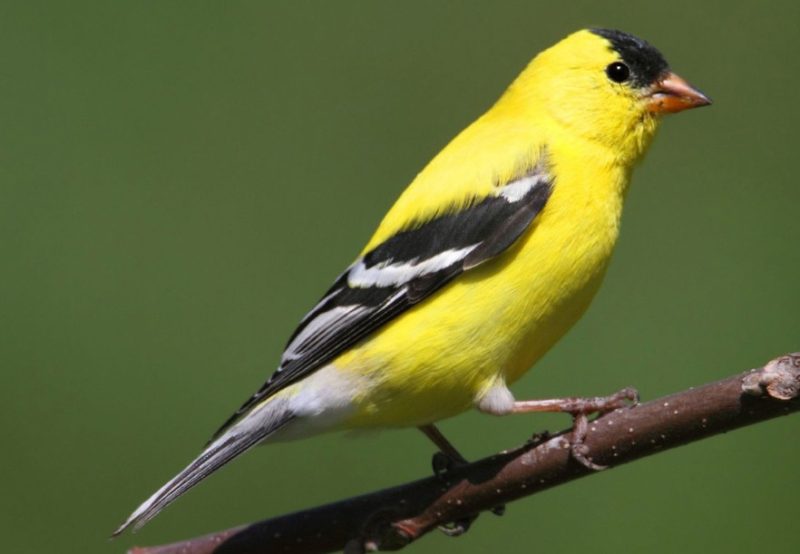
The American Goldfinch is a vibrant, small finch known for its striking coloration and cheerful song. Males in breeding season are bright yellow with a black forehead, black wings with white markings, and a white rump. Females are duller, with more olive-brown tones. These birds are petite, measuring about 4.3 to 5.1 inches in length, with a short, conical bill and a bouncy flight pattern.
Goldfinches are seed specialists and feed heavily on thistles, sunflowers, and dandelions. Their flight call is a sweet “per-chick-o-ree,” and their song is a light, twirling melody. They breed later than many songbirds, often waiting until mid to late summer when seed supplies are abundant. Their nests are neatly woven in shrubs or low trees, often camouflaged among foliage.
In Idaho, American Goldfinches are widespread in open areas such as meadows, weedy fields, gardens, and suburban areas. They are more common in the warmer months across the state and may migrate out of northern Idaho in winter. However, in southern regions with milder conditions, some populations remain year-round near feeders.
Song Sparrow (Melospiza melodia)
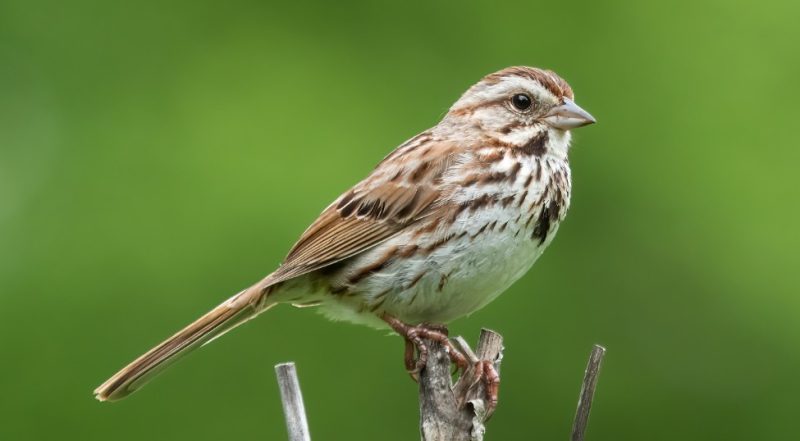
The Song Sparrow is a medium-sized, streaky brown bird with a rounded head, long tail, and a bold central breast spot. Its plumage varies slightly by region, but most individuals have brown upperparts with darker streaks, grayish facial stripes, and streaked underparts. Measuring about 5.9 to 6.7 inches long, this sparrow blends easily into brushy environments.
Song Sparrows are named for their rich and varied song, which often begins with clear notes followed by trills and buzzes. Males sing persistently to defend territory and attract mates. These birds forage on the ground for seeds and insects, flicking their tails and hopping among leaf litter or low vegetation. They nest in dense shrubs or grass clumps, often near water.
In Idaho, Song Sparrows are found statewide in wetland edges, riparian thickets, gardens, and even city parks. They are particularly common in areas with brushy cover. While some populations migrate, many remain in Idaho through the winter, especially where food and shelter are available.
Dark-eyed Junco (Junco hyemalis)

The Dark-eyed Junco is a small, ground-dwelling sparrow with several regional color variations. In Idaho, the most common type is the “Oregon” form, which features a dark gray or blackish hood, warm brown back, and pale underparts. All forms have a pink bill and white outer tail feathers that flash during flight. These birds typically measure around 5.5 to 6.3 inches in length.
Juncos are familiar winter visitors, often seen hopping on the ground under feeders or scratching through snow in search of seeds. They emit soft chips and have a simple musical trill as their song. These birds are highly active, social in flocks, and frequently forage near forest edges or underbrush, especially in colder months.
In Idaho, Dark-eyed Juncos are widespread, especially during fall and winter when they descend from higher elevations. They inhabit coniferous and mixed forests in the summer, particularly in mountainous areas, and move into towns, parks, and open lowlands in colder seasons. Their adaptability makes them a common sight across the state.
Western Tanager (Piranga ludoviciana)

The Western Tanager is a brilliantly colored bird that stands out with its tropical-like appearance. Males are especially eye-catching with bright yellow bodies, black wings with two white wing bars, and fiery red heads during the breeding season. Females are duller yellow with olive or gray tones. These medium-sized songbirds measure about 6.3 to 7.5 inches in length and have a sturdy, pointed bill.
Western Tanagers are somewhat shy and often remain high in the tree canopy, where they forage for insects and fruit. Their call is a dry “pit-er-ick,” and their song resembles a hoarse robin’s melody. During nesting season, they build well-hidden nests in conifer trees, usually placed far out on horizontal branches.
In Idaho, Western Tanagers breed in coniferous forests, especially in mountainous and northern regions. They are most often seen during spring and early summer as they migrate and settle into forested habitats. Although they spend the winter in Central America, their bright presence adds color to Idaho’s forests during the warmer months.
Barn Swallow (Hirundo rustica)

The Barn Swallow is a graceful, agile flyer with a deeply forked tail and glossy blue-black upperparts. Its throat and forehead are rusty red, and its underparts range from buff to pale orange. This slender bird measures about 5.9 to 7.5 inches long and is easily recognized by its acrobatic flight and long tail streamers that trail behind it while it swoops for insects.
Barn Swallows are highly aerial, spending much of their time gliding and darting through the air as they catch flying insects. Their cheerful twittering calls are a common sound near fields, barns, and water. These birds build mud cup nests under eaves, bridges, or inside barns—any sheltered spot that offers protection and access to open space.
In Idaho, Barn Swallows are a common summer resident throughout open areas including farmland, grasslands, and towns. They return in spring to breed and are especially abundant in southern and central parts of the state. By early fall, they begin migrating south to Central and South America for the winter.
Yellow Warbler (Setophaga petechia)

The Yellow Warbler is a small, vibrant songbird known for its pure yellow plumage. Males are bright yellow with reddish streaks on the chest, while females are slightly duller without the streaking. Both sexes have rounded heads, black eyes, and slender, pointed bills. These birds measure about 4.7 to 5.1 inches long and are often seen flitting among trees and shrubs.
These warblers are very vocal, with a cheerful “sweet-sweet-sweet, I’m so sweet” song that carries well through wooded areas. They forage actively for insects, often in willow thickets or along streams. Yellow Warblers build cup-shaped nests in low shrubs, carefully weaving them with grasses, fibers, and plant down.
In Idaho, Yellow Warblers are common during spring and summer, especially near riparian corridors, wet meadows, and shrubby forest edges. They breed widely across the state wherever water and dense vegetation are present. By late summer, they begin their long migration to Central and South America.
Red-winged Blackbird (Agelaius phoeniceus)
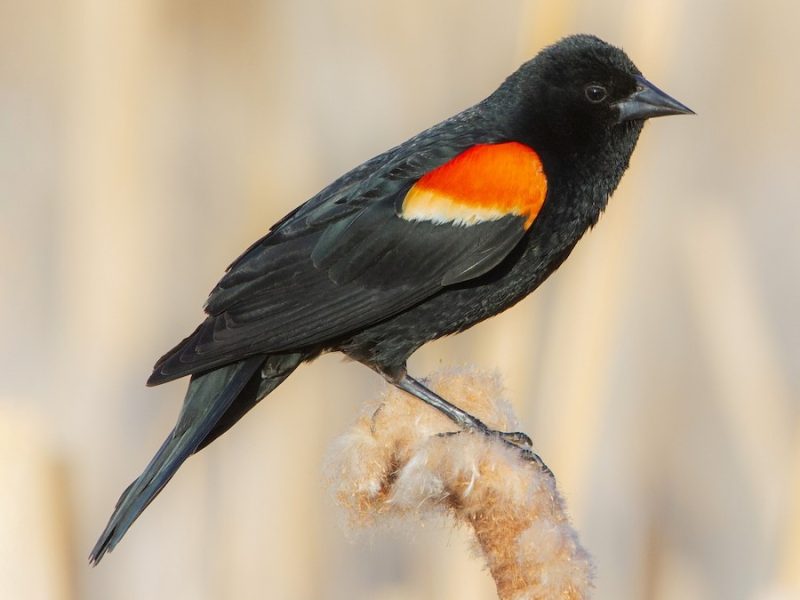
The Red-winged Blackbird is a medium-sized, stocky bird best known for the male’s striking black plumage and vivid red-and-yellow shoulder patches. Females are heavily streaked brown with a more subdued appearance. These birds measure about 6.7 to 9.1 inches long and have strong legs and a conical bill adapted for cracking seeds.
Males are territorial and sing a distinctive “conk-a-ree” call from cattails or fence posts during breeding season. They gather in large flocks outside of the breeding period, foraging in fields and marshes. Red-winged Blackbirds are polygynous, with a single male often guarding multiple nests placed among reeds or grasses.
In Idaho, they are among the most abundant and widespread birds, especially near wetlands, ponds, irrigation ditches, and agricultural lands. They breed throughout the state in spring and summer, and many individuals remain into the colder months, particularly in southern Idaho where conditions are milder.
Western Meadowlark (Sturnella neglecta)

The Western Meadowlark is a stout, robin-sized bird with a bright yellow chest and bold black “V” across its breast. Its back is mottled brown and white, providing excellent camouflage in grassland settings. These birds measure about 6.3 to 10.2 inches in length and have a long, pointed bill and short tail.
Known for their flute-like, melodic songs, Western Meadowlarks often sing from fence posts or shrubs. They forage on the ground for insects and seeds, and build grass nests in shallow depressions hidden among tall grasses. Their flight is low and fluttering, often just above the tops of the prairie vegetation.
In Idaho, Western Meadowlarks are common in open fields, meadows, pastures, and prairies across the state. They are year-round residents in many southern and central areas, but northern populations may migrate south in winter. As the official state bird of several western states, their song is a familiar sound in Idaho’s countryside.
Lazuli Bunting (Passerina amoena)
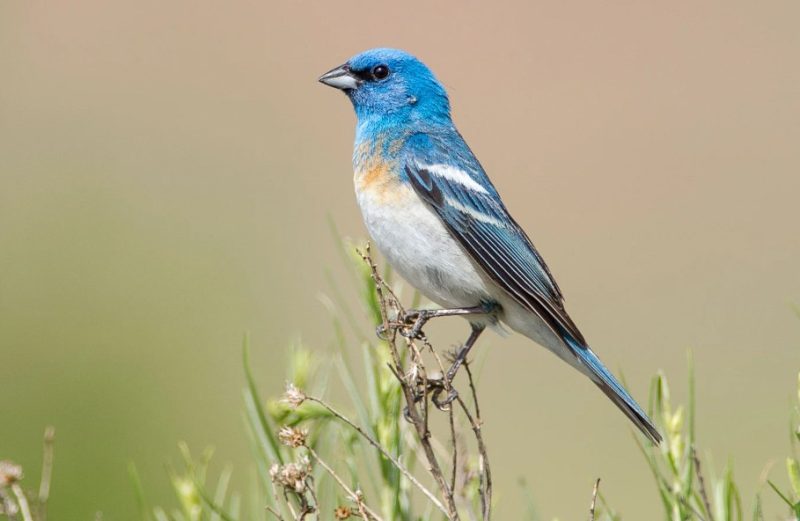
The Lazuli Bunting is a brilliantly colored songbird, with adult males showing vivid sky-blue heads and backs, a rusty orange breast, and white belly. Females are more subtly colored with brownish tones and pale underparts. These small, sparrow-sized birds measure about 5.1 to 5.9 inches in length and have a stout, conical bill ideal for seed eating.
Lazuli Buntings are often heard before they are seen, singing a sweet, high-pitched warble from shrubs or treetops. Males are especially vocal during the breeding season, defending territories with persistent song. They forage on the ground or in low vegetation for seeds, berries, and insects, and often visit feeders during migration.
In Idaho, Lazuli Buntings are summer residents, breeding in open woodlands, sagebrush areas, brushy canyons, and foothills across much of the state. They are most common in southern and western regions during spring and summer. In fall, they migrate to Mexico and the southwestern U.S., returning to Idaho again in late spring.
Steller’s Jay (Cyanocitta stelleri)
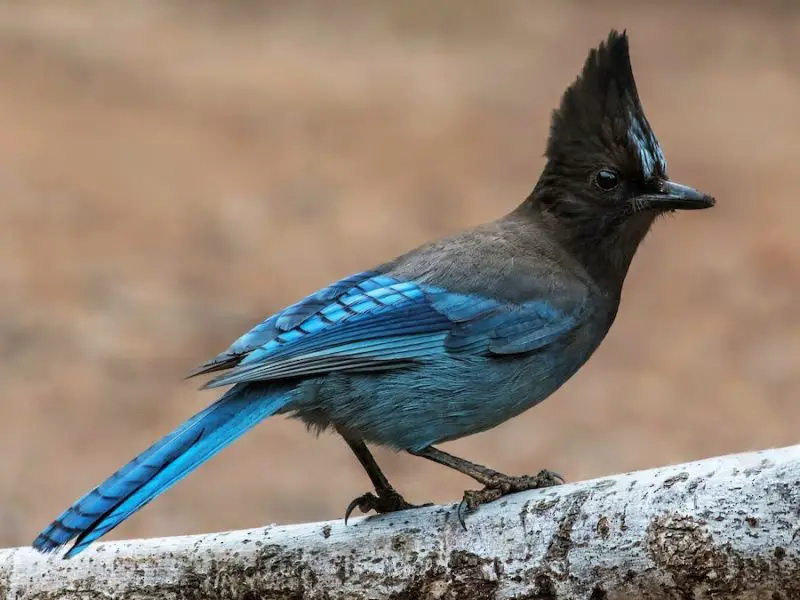
Steller’s Jay is a bold and striking bird with a prominent crest and deep blue body. Its head and crest are black to dark charcoal, while the rest of its plumage transitions into vibrant blue with lighter barring on the wings and tail. Measuring about 11.8 to 13.4 inches long, it is one of the larger members of the jay family and has a stout bill ideal for cracking seeds and nuts.
These jays are highly vocal and intelligent, often mimicking other birds or sounds such as hawk calls. They forage both on the ground and in trees, feeding on insects, berries, seeds, and even human food scraps in campgrounds. Their behavior is bold and inquisitive, frequently seen hopping through the forest understory or visiting feeders in wooded areas.
In Idaho, Steller’s Jays are found primarily in coniferous forests, especially in mountainous regions of the north and central parts of the state. They are year-round residents, adapting well to forest edges, pine woodlands, and elevations ranging from foothills to alpine zones. Their presence is often announced by their loud, raspy “shack-shack” calls.
Northern Flicker (Colaptes auratus)
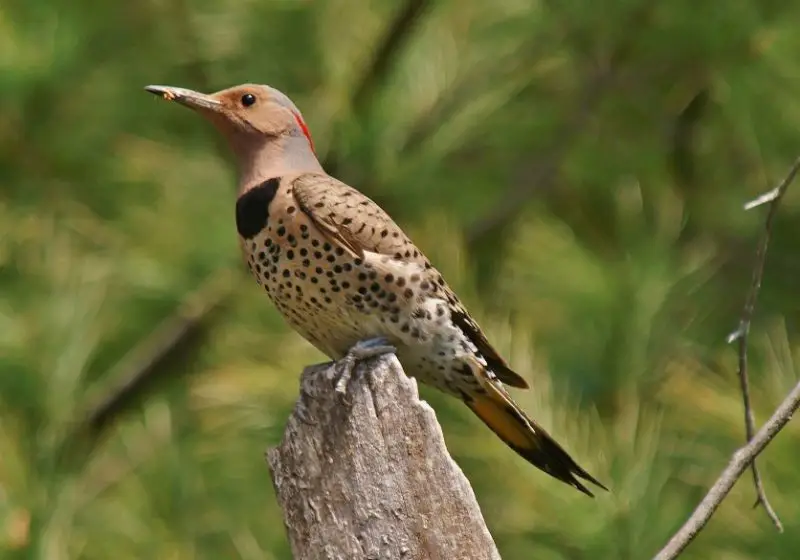
The Northern Flicker is a large, ground-foraging woodpecker with a unique appearance. In Idaho, the most common variety is the “red-shafted” form, which has brownish-gray plumage with black bars on the back, a spotted belly, and a bright red patch on the face and under the wings and tail. These birds measure about 11 to 14 inches long and have a slightly curved bill used for probing the ground.
Unlike most woodpeckers, Northern Flickers are often seen on the ground, searching for ants and beetles, their primary diet. Their call is a loud, repeated “kleer” or a rapid burst of drumming on hollow trees. They nest in tree cavities and are frequently seen in open woodlands, forest edges, and even suburban areas.
In Idaho, Northern Flickers are common throughout the state in both lowlands and mountainous areas. They are year-round residents in many regions, particularly where mild winters allow for sufficient food sources. During colder months, some may move to lower elevations or migrate farther south.
Pileated Woodpecker (Dryocopus pileatus)

The Pileated Woodpecker is the largest woodpecker species in North America, easily recognized by its black body, white neck stripes, and flaming red crest. Both males and females are impressive in size, measuring about 16 to 19 inches long, with a powerful chisel-like bill and strong claws that help them cling to tree trunks.
These woodpeckers are known for their loud, echoing calls and deep drumming that resonate through the forest. They excavate large rectangular holes in dead trees while searching for carpenter ants and wood-boring beetle larvae. Their excavations also provide nesting cavities for other forest wildlife. Pileated Woodpeckers are typically shy and elusive but can be spotted flying with heavy wingbeats between large trees.
In Idaho, Pileated Woodpeckers inhabit mature forests, especially in the northern panhandle where extensive woodlands provide suitable habitat. They prefer dense coniferous or mixed hardwood forests and are permanent residents in these areas. Their presence is often revealed by the sound of wood chips falling from trees or their distinctive jungle-like calls.
Downy Woodpecker (Dryobates pubescens)

The Downy Woodpecker is a small, compact woodpecker with a checkered black-and-white pattern. Males have a small red patch on the back of the head, while females lack this marking. Both sexes have white undersides, black wings with white spots, and a black-and-white striped head. Measuring about 5.5 to 6.7 inches long, it is the smallest woodpecker in North America.
Downy Woodpeckers are agile and often seen climbing tree trunks or hanging from twigs as they search for insects. They emit a short, sharp “pik” call and a descending whinny-like trill. These woodpeckers nest in small cavities they excavate in soft or dead wood and are frequent visitors to suet feeders in winter.
In Idaho, Downy Woodpeckers are widespread and common in forests, suburban parks, and riparian corridors. They are year-round residents throughout most of the state and adapt well to a variety of habitats including mixed woodlands, orchards, and backyard trees. Their small size allows them to forage in thinner branches where larger woodpeckers cannot reach.
Hairy Woodpecker (Dryobates villosus)

The Hairy Woodpecker closely resembles the Downy Woodpecker but is noticeably larger and has a longer, sturdier bill. Adults have a crisp black-and-white pattern with a white back, black wings with white spots, and white underparts. Males have a red patch on the rear of the head. They measure about 7.1 to 10.2 inches long, with a straight posture and bold appearance.
These woodpeckers are strong and deliberate, using their robust bills to excavate bark and wood in search of beetles, larvae, and ants. Their call is a sharp “peek,” and their drumming is louder and more forceful than that of smaller woodpeckers. Hairy Woodpeckers often forage on tree trunks and larger branches, sometimes following mixed-species flocks in forested areas.
In Idaho, Hairy Woodpeckers are found year-round in wooded habitats across the state. They are particularly common in mature conifer and mixed forests, from lowland groves to mountain woodlands. Their adaptability also allows them to inhabit city parks and larger gardens with mature trees, making them a familiar sight to observant birdwatchers.
Red-breasted Nuthatch (Sitta canadensis)
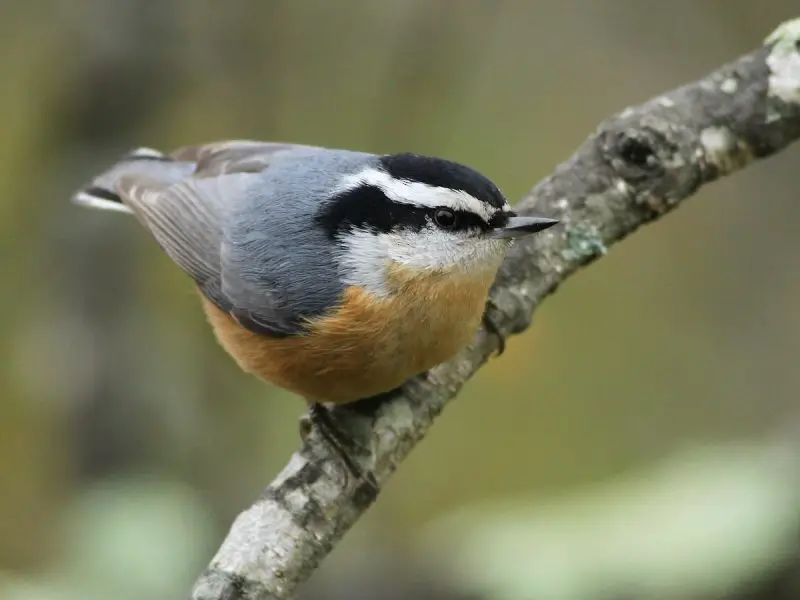
The Red-breasted Nuthatch is a small, agile songbird with a compact body, short tail, and sharp bill. Its striking features include a blue-gray back, rusty-red underparts, a black crown, and a bold white eyebrow contrasting with a black eye-stripe. Measuring about 4.3 inches long, it often appears busy as it scurries up and down tree trunks in search of insects and seeds.
These birds are known for their nasal “yank-yank” calls and their ability to climb both up and down trees—something few birds do as skillfully. Red-breasted Nuthatches often forage by creeping along bark surfaces, probing into crevices with their thin bills. In colder months, they readily visit feeders for sunflower seeds and suet, storing extra food in bark crevices for winter.
In Idaho, they are year-round residents in coniferous forests, especially in mountainous regions and higher elevations. They are common throughout the Panhandle and central parts of the state but may also descend into lower valleys in winter. Their preference for pine and spruce makes them a familiar bird in Idaho’s alpine landscapes.
Brown Creeper (Certhia americana)

The Brown Creeper is a tiny, well-camouflaged songbird with mottled brown upperparts, white underparts, and a thin, curved bill. It has a stiff tail that helps support its body as it spirals up tree trunks in search of insects. Measuring about 4.7 to 5.5 inches in length, the Brown Creeper blends easily into bark, making it challenging to spot despite its widespread presence.
Creepers move in a characteristic upward spiral, using their curved bills to pry insects and spiders from beneath bark flakes. Their high-pitched, thin song can be difficult to hear but is often the first clue to their presence. They nest behind loose bark or in natural tree crevices, using bark strips, moss, and feathers to line the nest.
In Idaho, Brown Creepers are year-round residents in mature forests, especially those dominated by large conifers. They are most frequently found in northern and central Idaho, from lowland woods to high mountain forests. During winter, they may move to lower elevations or mixed woodlands, where they continue foraging on tree trunks in their quiet, methodical way.
Golden-crowned Kinglet (Regulus satrapa)
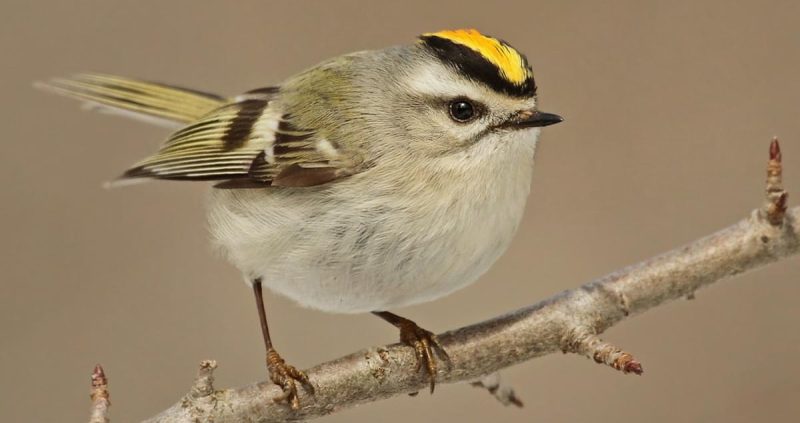
The Golden-crowned Kinglet is a tiny, energetic bird with olive-gray plumage, a pale face, and a bold black-and-white facial pattern. Its most distinctive feature is the yellow crown bordered with black; males have an orange center in the crown that flashes during displays. Measuring only about 3.1 to 4.3 inches long, this bird is among the smallest in North America.
Kinglets are constantly on the move, flicking their wings and hopping through coniferous branches in search of tiny insects, spiders, and eggs. Their thin, high-pitched calls and fast-paced trills are characteristic of the species. Despite their size, Golden-crowned Kinglets are remarkably hardy and can survive frigid temperatures by roosting communally.
In Idaho, they are found year-round in dense coniferous forests, particularly in the Panhandle and central mountainous regions. During migration and winter, they may venture into mixed woodlands and lower elevations. Their small size and active behavior make them a delight to watch for birders who venture into Idaho’s evergreen habitats.
Ruby-crowned Kinglet (Corthylio calendula)
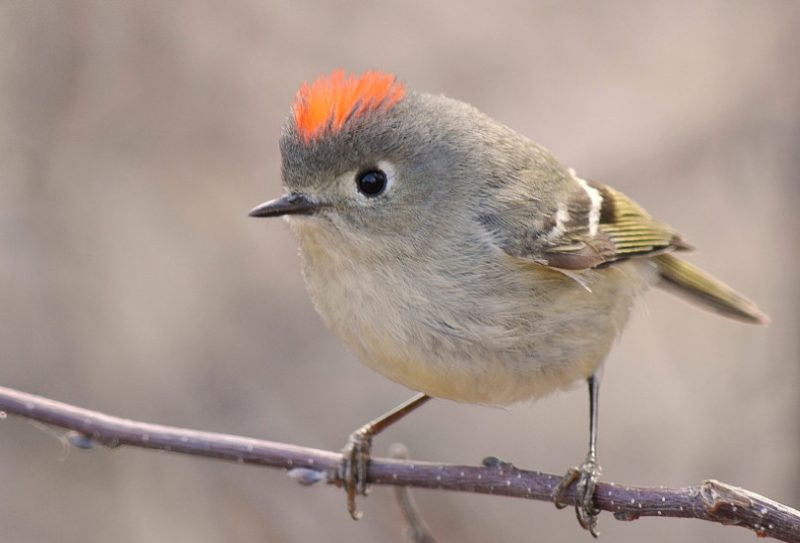
The Ruby-crowned Kinglet is a tiny, olive-green songbird with a distinctive eye-ring and nervous wing-flicking behavior. Males possess a hidden red crown patch that is usually concealed but can be raised when excited or displaying. Females lack the ruby crown. These birds are slightly larger than their golden-crowned relatives, measuring about 3.5 to 4.3 inches long.
Despite their small size, Ruby-crowned Kinglets are energetic foragers, often flitting rapidly among branches in search of insects and spiders. They have a surprisingly loud and complex song, consisting of rapid notes and musical warbles. This song is usually heard during the breeding season in northern or higher elevation forests.
In Idaho, Ruby-crowned Kinglets are widespread during migration and summer, especially in moist coniferous and mixed forests. They breed in mountainous regions of central and northern Idaho and are often seen in lowland woodlands, thickets, and even urban parks during spring and fall migration. Some may linger in southern Idaho during mild winters, particularly in sheltered habitats.
Bald Eagle (Haliaeetus leucocephalus)
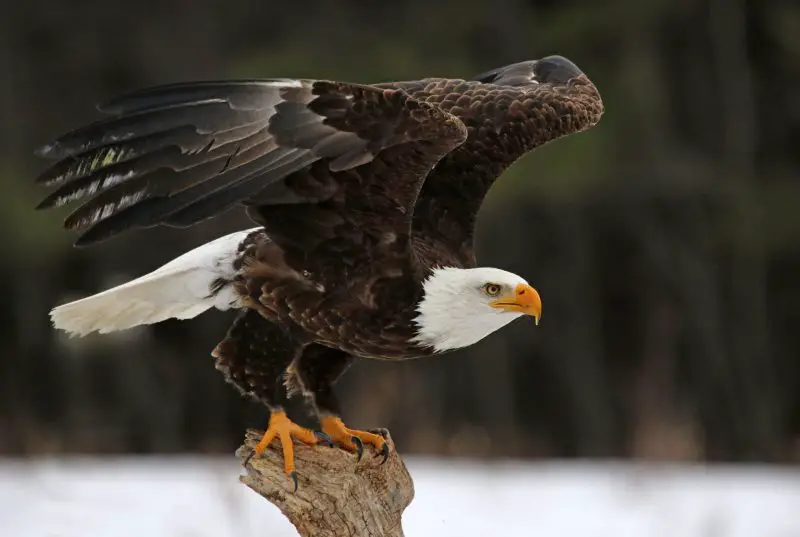
The Bald Eagle is a large and iconic raptor known for its white head and tail contrasting with a dark brown body and wings. Adults have bright yellow beaks and eyes, while immature birds are mostly mottled brown until they reach full adult plumage at around five years old. With a wingspan of up to 7.5 feet and a body length of 28 to 40 inches, it is one of the largest birds of prey in North America.
These eagles are skilled fish hunters, often seen soaring above lakes and rivers or perched in tall trees near water. They primarily feed on fish but also scavenge carrion and occasionally hunt waterfowl. Their piercing call and enormous nests—often reused and added to yearly—make them a dramatic presence in the landscape.
In Idaho, Bald Eagles are commonly found along major rivers, reservoirs, and lakes, especially during winter when they gather to feed on fish and waterfowl. They nest throughout the state, with strong populations in the Panhandle and Snake River regions. Conservation efforts have helped this once-threatened species recover across its range.
Golden Eagle (Aquila chrysaetos)
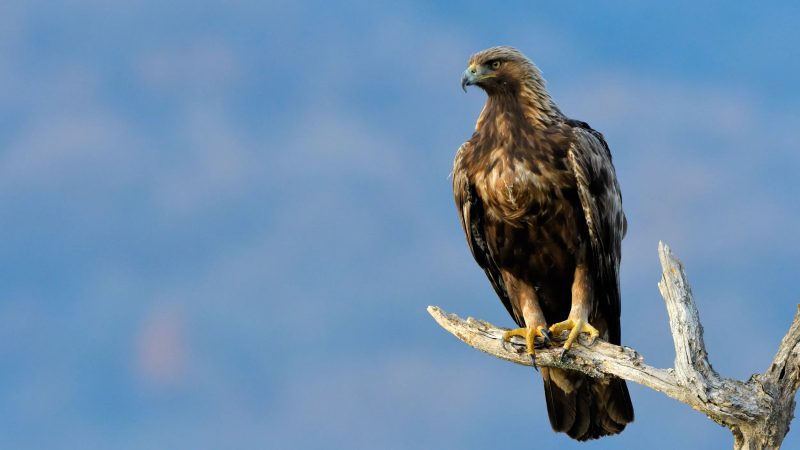
The Golden Eagle is a majestic raptor with dark brown plumage and golden feathers on the back of the head and neck. Larger than most other birds of prey, it measures 26 to 40 inches in length with a wingspan reaching up to 7.5 feet. Adults have feathered legs down to the feet and powerful talons suited for hunting large prey.
These eagles prefer open habitats like deserts, grasslands, and mountain slopes, where they soar effortlessly in search of rabbits, ground squirrels, and other mammals. Golden Eagles are stealthy hunters, often using updrafts to glide silently above cliffs and hillsides before diving on their prey. They are less likely to scavenge than Bald Eagles and tend to be more elusive.
In Idaho, Golden Eagles are year-round residents, especially in the southern and central parts of the state. They nest on cliffs, steep hillsides, or sometimes in large trees in remote areas. The wide-open spaces of southern Idaho’s rangelands and canyons provide prime hunting territory for this powerful bird.
Red-tailed Hawk (Buteo jamaicensis)
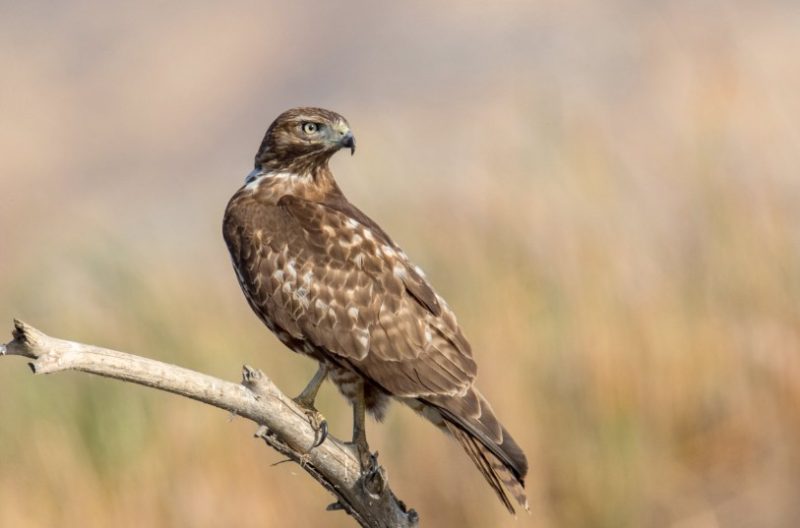
The Red-tailed Hawk is a stocky, broad-winged raptor commonly recognized by its reddish-brown tail and pale underside with a dark belly band. Plumage can vary widely in color from light to dark morphs, but its large size—18 to 26 inches long with a wingspan of about 4 feet—and robust build make it easy to identify in flight or perched.
Red-tailed Hawks often soar high on thermals, scanning the ground for small mammals like mice, voles, and rabbits. They are also known for their loud, rasping scream, frequently used in movies to represent any bird of prey. Nests are typically built high in trees or on cliffs, using sticks lined with softer materials.
In Idaho, Red-tailed Hawks are widespread and common in open country, along highways, grasslands, agricultural fields, and forest edges. They are year-round residents throughout much of the state, especially in southern and central areas. Their adaptability to human-altered landscapes makes them one of Idaho’s most visible hawks.
Swainson’s Hawk (Buteo swainsoni)

Swainson’s Hawk is a slender, long-winged raptor with pointed wingtips and a pale body contrasted by a dark bib on the chest. It measures about 18 to 22 inches long with a wingspan of up to 4.5 feet. Its plumage can range from light to dark morphs, and it has a distinct two-toned underwing visible during flight.
These hawks are highly migratory, traveling thousands of miles to and from South America each year. During summer in Idaho, they hunt in open country, primarily feeding on insects like grasshoppers and dragonflies, especially during the breeding season. They are social and often seen in groups, particularly during migration.
In Idaho, Swainson’s Hawks are summer residents in the southern and eastern parts of the state, especially in grasslands, farmland, and sagebrush steppe. They are most active from late April through September, nesting in isolated trees, utility poles, or shelterbelts near open terrain.
Northern Harrier (Circus hudsonius)
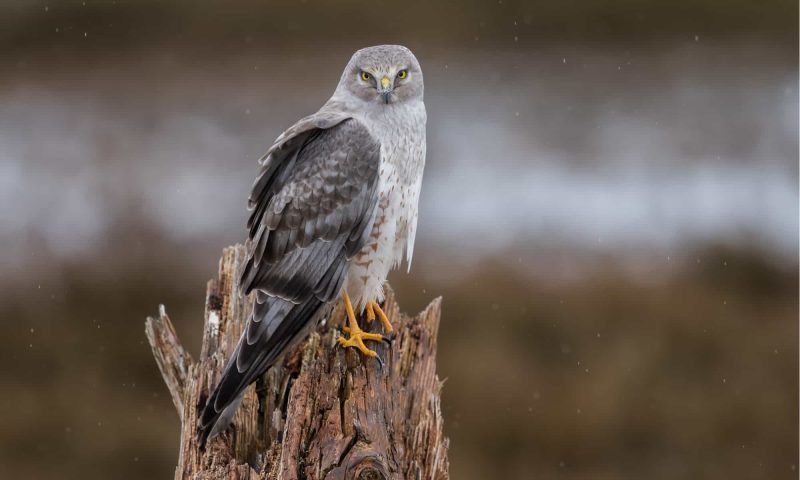
The Northern Harrier is a slim, medium-sized raptor with long wings and a distinctive white rump patch. Males are pale gray above and white below, while females and juveniles are brown with streaked underparts. Measuring 18 to 20 inches in length with a wingspan of around 3.5 to 4.5 feet, it glides low over fields with its wings held in a V-shape.
Northern Harriers hunt by flying low over marshes, grasslands, and fields, listening and watching for small mammals and birds. They have an owl-like facial disk that helps them detect prey by sound. They nest on the ground in tall grasses or reeds, often near wetlands, and their flight is buoyant and graceful.
In Idaho, Northern Harriers are found throughout the state, especially in open wetlands and meadows. They breed in suitable habitats during spring and summer and are commonly seen in southern Idaho year-round. Their hunting style and unique flying posture make them easy to recognize even from a distance.
American Kestrel (Falco sparverius)

The American Kestrel is the smallest falcon in North America, with a colorful plumage and agile flight. Males display a blue-gray head and wings, rusty back, and spotted underparts, while females are more uniformly rusty with black streaking. These tiny falcons measure about 8 to 11 inches in length with a wingspan of 20 to 24 inches.
Kestrels are quick and agile hunters, often seen perched on wires or hovering in place while scanning for insects, lizards, and small rodents. They frequently nest in cavities, such as old woodpecker holes, nest boxes, or even building crevices. Their high-pitched calls and flickering wingbeats are distinctive signs of their presence.
In Idaho, American Kestrels are common across the state in open areas like fields, grasslands, deserts, and farmlands. They are present year-round in much of southern Idaho, with some northern populations migrating south for winter. Their adaptability to both rural and urban environments makes them one of Idaho’s most familiar raptors.
Peregrine Falcon (Falco peregrinus)
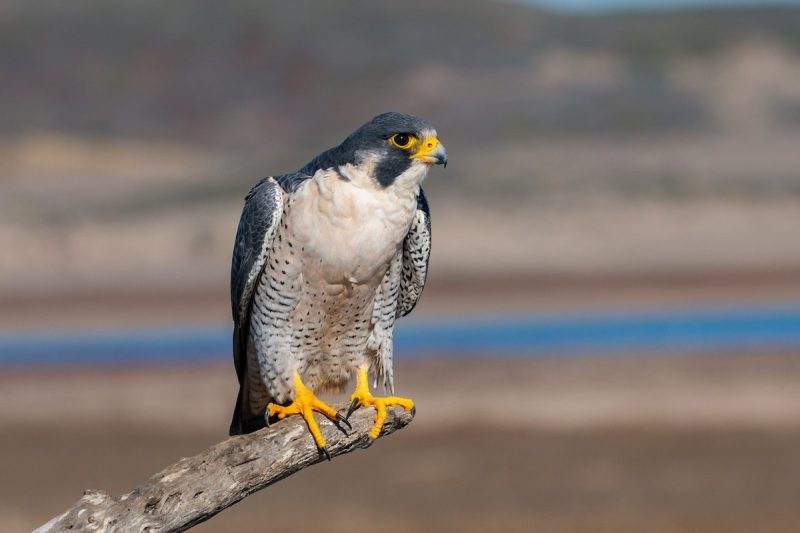
The Peregrine Falcon is a powerful and streamlined raptor known for its incredible speed—diving at over 200 miles per hour to strike prey mid-air. Adults have a blue-gray back, black head with a bold mustache mark, and pale underparts with dark barring. Measuring 14 to 19 inches in length with a wingspan up to 43 inches, this falcon is built for agility and precision.
Peregrines primarily hunt birds, capturing them in flight with swift aerial maneuvers. They often perch on high cliffs or urban buildings, using elevation to their advantage when spotting prey. Their sharp, repeated “kek-kek-kek” calls are heard near nesting sites, which are often located on ledges or cliff faces.
In Idaho, Peregrine Falcons nest on cliffs, especially along the Snake River Canyon and in mountainous areas. They are also seen in cities where tall buildings mimic natural nesting sites. Once endangered due to pesticide use, the species has rebounded strongly and is now a celebrated success in raptor conservation throughout the state.
Osprey (Pandion haliaetus)
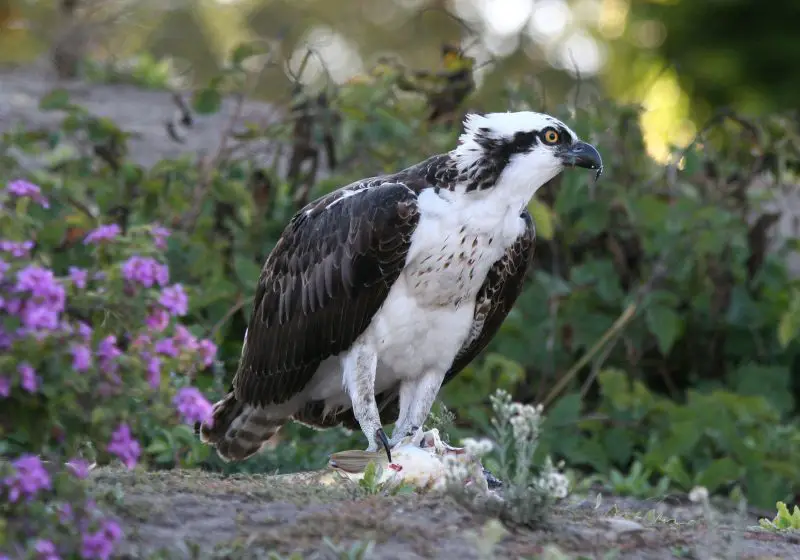
The Osprey is a large, fish-eating raptor easily recognized by its white underparts, dark brown back, and striking dark eye-stripe across its pale head. With a body length of 21 to 23 inches and a wingspan of 5 to 6 feet, the Osprey is often seen hovering above water before plunging feet-first to catch fish with its reversible outer toes and barbed talons.
These birds build large stick nests near water—on tree tops, poles, or nesting platforms—and return to the same site year after year. Their shrill “cheep-cheep” calls are common in nesting areas during breeding season. Ospreys are typically monogamous and highly territorial around nesting zones.
In Idaho, Ospreys are widespread in the warmer months, especially near lakes, reservoirs, and rivers such as the Snake, Clearwater, and Pend Oreille. They migrate south for winter, returning in spring to raise their young. Nesting platforms installed by wildlife agencies have helped expand their breeding range across the state.
Great Horned Owl (Bubo virginianus)
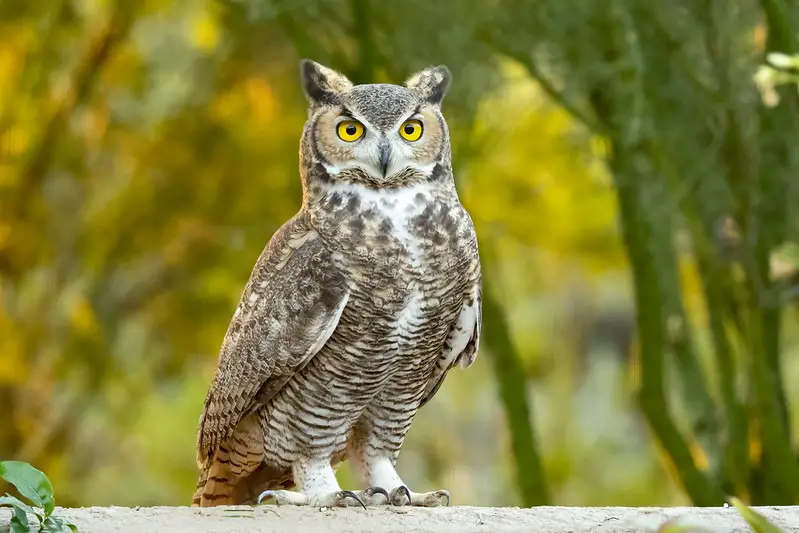
The Great Horned Owl is a large and formidable nocturnal predator with prominent ear tufts, a deep hooting voice, and piercing yellow eyes. It has mottled brown and gray plumage, a white throat patch, and a bulky body, measuring 18 to 25 inches long with a wingspan up to 5 feet. Its strong talons and silent flight make it a powerful night hunter.
This owl preys on a wide variety of animals, from rabbits and rodents to birds, reptiles, and even skunks. It nests early in the season—often using abandoned nests of other birds or tree cavities—and is known for its deep, resonant “hoo-h’HOO-hoo-hoo” call that echoes across forests and fields at night.
In Idaho, Great Horned Owls are year-round residents across all habitats, including forests, deserts, farmlands, and urban areas. They are highly adaptable and can be found statewide, from mountain foothills to city parks. Their haunting calls and commanding presence make them one of the most recognizable owls in the state.
Northern Pygmy-Owl (Glaucidium gnoma)
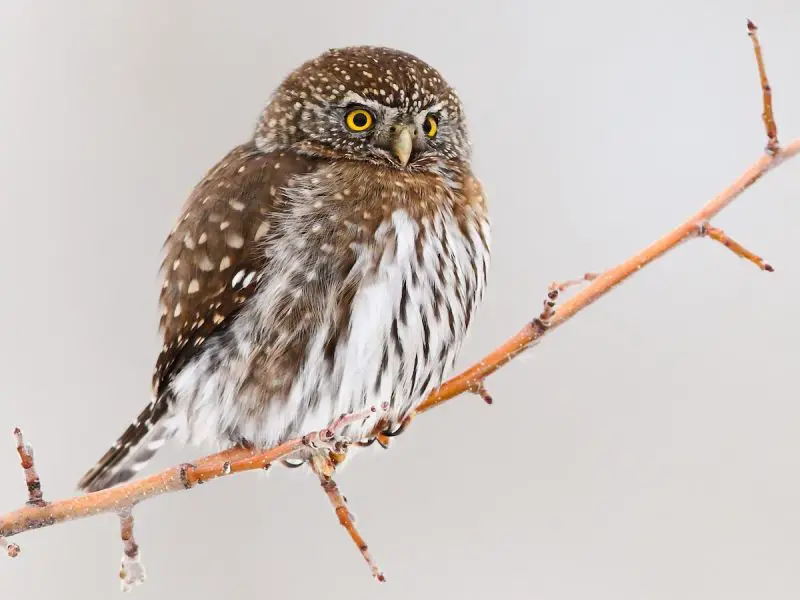
The Northern Pygmy-Owl is a small but fierce owl with a round head, yellow eyes, and no ear tufts. Its plumage is brown with white spots on the head and streaked underparts. Despite its tiny size—just 6 to 7 inches long with a wingspan of about 15 inches—it is an agile and effective daytime hunter.
This owl is unusual among owls because it hunts during daylight, often ambushing birds and small mammals from a perch. It has a high-pitched, evenly spaced series of “toot” notes that often give away its presence. It is also known for the false eye-spots on the back of its head, which may deter predators.
In Idaho, Northern Pygmy-Owls inhabit forests across the central and northern parts of the state, especially in coniferous woodlands at mid to high elevations. They are year-round residents in these areas but are difficult to spot due to their size and quiet, still hunting behavior. Birders often locate them by listening for their rhythmic tooting calls in the forest canopy.
Canada Goose (Branta canadensis)
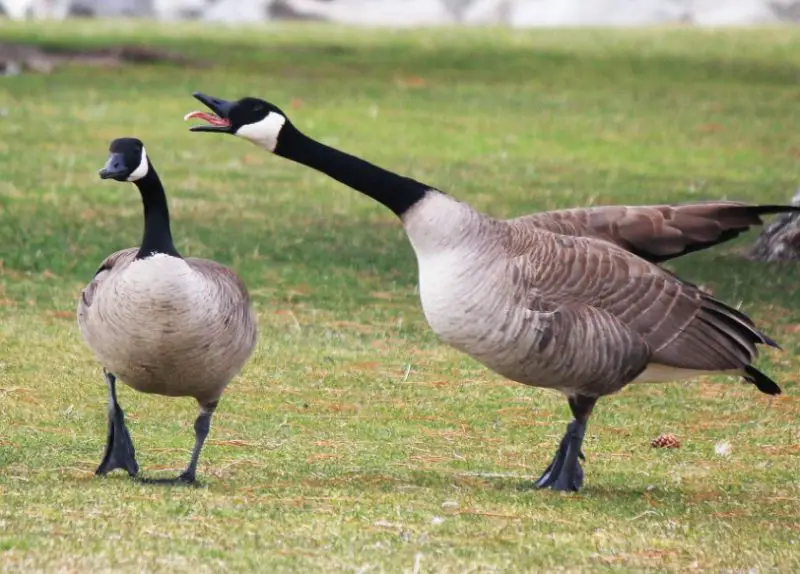
The Canada Goose is a large, familiar waterfowl species known for its black head and neck, white chinstrap, and brownish-gray body. Adults typically measure between 30 to 43 inches long with a wingspan of up to 6 feet. Their deep honking calls and V-shaped migratory flocks are among the most iconic sights and sounds of North American wetlands.
These geese graze on grasses and grains, often foraging in open fields, shorelines, and city parks. During breeding season, they form strong pair bonds and aggressively defend nests built near water. Canada Geese are highly adaptable and can thrive in both wild and urban environments.
In Idaho, they are common year-round in the southern and western parts of the state, especially around lakes, rivers, and agricultural lands. Large flocks are often seen in the Treasure Valley, Boise River area, and along the Snake River. Some populations are migratory, while others now reside in Idaho year-round due to plentiful food and open water.
Mallard (Anas platyrhynchos)

The Mallard is one of the most widespread and recognizable ducks in North America. Males are distinguished by their iridescent green heads, white neck rings, and chestnut-brown breasts, while females are mottled brown with orange bills. Mallards measure 20 to 26 inches long with a wingspan around 32 to 37 inches.
They are dabbling ducks, feeding on aquatic vegetation, insects, and grains by tipping forward in shallow water rather than diving. Mallards are social, often forming loose flocks in wetlands, lakes, and ponds. Their familiar quacking—mostly made by females—adds to their presence in marshy areas.
In Idaho, Mallards are abundant year-round in many regions, especially in the Snake River Plain, wetlands of the Panhandle, and suburban parks. They breed throughout the state and are the most common duck encountered in both natural and urban wetland settings. Migratory flocks swell their numbers in spring and fall.
Wood Duck (Aix sponsa)
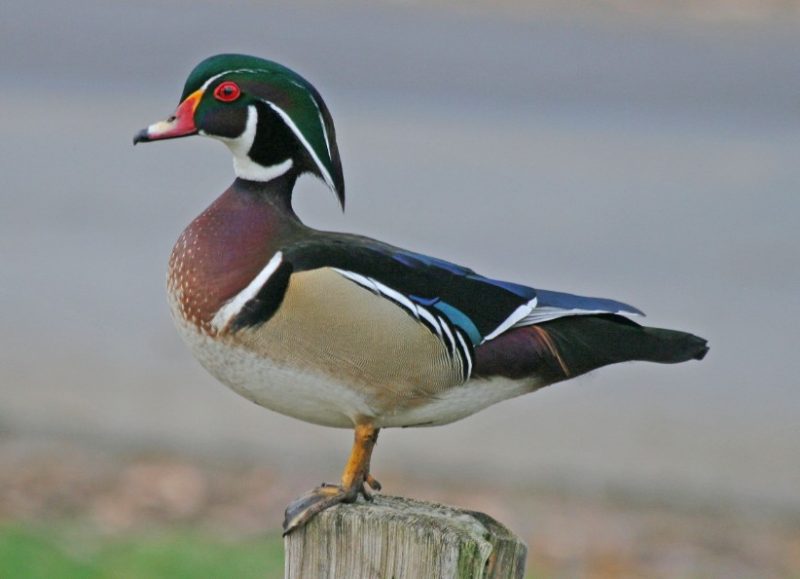
The Wood Duck is a stunningly colorful species, especially the male, which sports iridescent green and purple on its head, red eyes, and ornate chestnut and white markings. Females are more subdued, with grayish-brown plumage and a distinct white eye-ring. These medium-sized ducks are 18 to 21 inches long with a wingspan around 26 to 29 inches.
Unlike most ducks, Wood Ducks nest in tree cavities near water and are agile fliers, often seen weaving through forests. Ducklings leap from the nest within a day of hatching, tumbling to the ground unhurt. They feed on seeds, insects, and aquatic plants in calm waters surrounded by trees.
In Idaho, Wood Ducks breed in forested wetland habitats, especially along slow-moving rivers, ponds, and swamps in the western and southern parts of the state. Nest boxes have helped support local populations. They are present from spring through fall, with some migrating south in winter.
American Coot (Fulica americana)

The American Coot is a medium-sized, slate-gray waterbird with a rounded head, white bill, and a small red patch above the bill. Although it resembles a duck, it belongs to the rail family and has lobed toes instead of webbed feet. Adults measure about 13 to 17 inches long with a wingspan around 23 to 28 inches.
Coots are strong swimmers and divers, often seen paddling across ponds and lakes in tight groups. They feed on aquatic vegetation, algae, and small invertebrates. On land, they walk with a distinctive bobbing motion, and in flight, they require a long, running takeoff across the water’s surface.
In Idaho, American Coots are common breeders in wetlands, marshes, and reservoirs across much of the state. They are especially numerous in southern Idaho and around larger bodies of water like Lake Lowell and Bear Lake. Many migrate south for winter, although some remain in ice-free waters year-round.
Great Blue Heron (Ardea herodias)
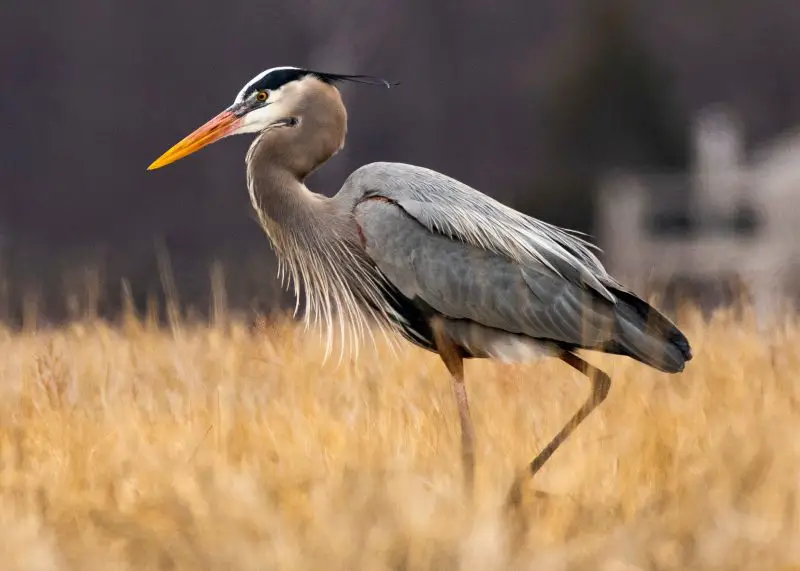
The Great Blue Heron is the largest heron in North America, standing up to 4.5 feet tall with a wingspan of 6 to 7 feet. It has slate-gray plumage, a long neck, dagger-like bill, and black plumes on the head. When flying, it tucks its neck into an S-shape and beats its wings slowly and gracefully.
Herons hunt by wading slowly through shallow water or standing still to ambush fish, frogs, and aquatic insects. They nest in colonies, often high in trees near water, building large stick nests. Their loud, croaking calls are frequently heard during flight or at nesting sites.
In Idaho, Great Blue Herons are widespread near lakes, rivers, and wetlands across the state. They breed in colonies throughout southern and northern Idaho, including areas near the Boise River, Coeur d’Alene Lake, and Snake River. While some migrate, many remain in southern Idaho where water stays open in winter.
Common Loon (Gavia immer)
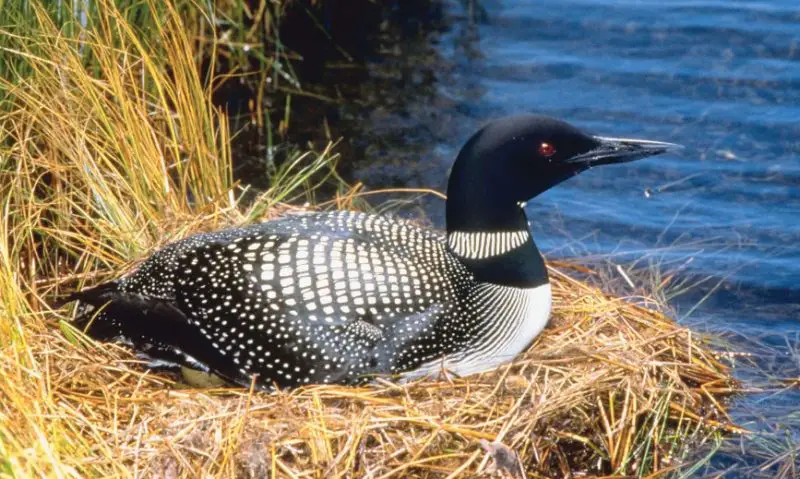
The Common Loon is a striking, fish-eating waterbird with a black head and neck, red eyes, and a checkered black-and-white back during breeding season. In winter, its plumage turns dull gray. It measures about 26 to 36 inches in length with a wingspan of 4.5 to 5.5 feet, and its haunting wail is a signature sound of northern lakes.
Loons dive with ease, using their powerful legs placed far back on their bodies for propulsion. They are excellent underwater hunters and require large lakes for takeoff and landing. Loons are monogamous and return to the same breeding lakes each year to raise their young.
In Idaho, Common Loons are occasional breeders in the northern part of the state, especially around larger lakes like Priest Lake and Lake Pend Oreille. They are more frequently seen during spring and fall migration. Idaho is at the southwestern edge of their breeding range, making their presence here noteworthy for birders.
Ring-necked Duck (Aythya collaris)
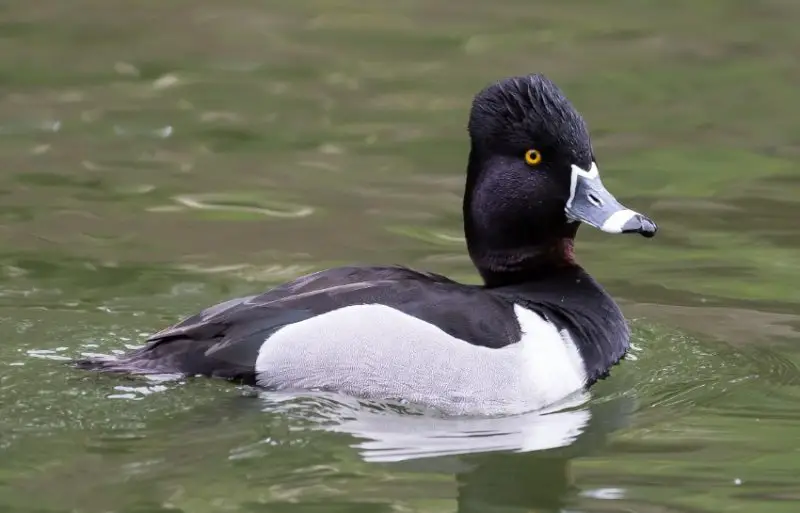
The Ring-necked Duck is a medium-sized diving duck recognized by its striking black and gray plumage, with males featuring a distinctive chestnut-colored ring around their neck (often hard to see) and a peaked head shape. They measure about 16 to 19 inches in length with a wingspan around 26 to 29 inches. Males have white rings on their bills and a sharp white line on their sides, while females are mottled brown with a less distinct bill pattern.
These ducks dive underwater to forage primarily on seeds, roots, and aquatic plants, often inhabiting deep lakes and ponds. They tend to be shy and are more commonly seen in mixed flocks during migration or winter. Their flight is fast and direct, and they often gather in large groups on open water.
In Idaho, Ring-necked Ducks are common migrants and winter visitors, frequenting wetlands, reservoirs, and lakes such as Lake Lowell and the Bear River Migratory Bird Refuge. They breed in northern parts of the state where suitable breeding ponds exist, often in forested or boggy areas.
Gadwall (Mareca strepera)
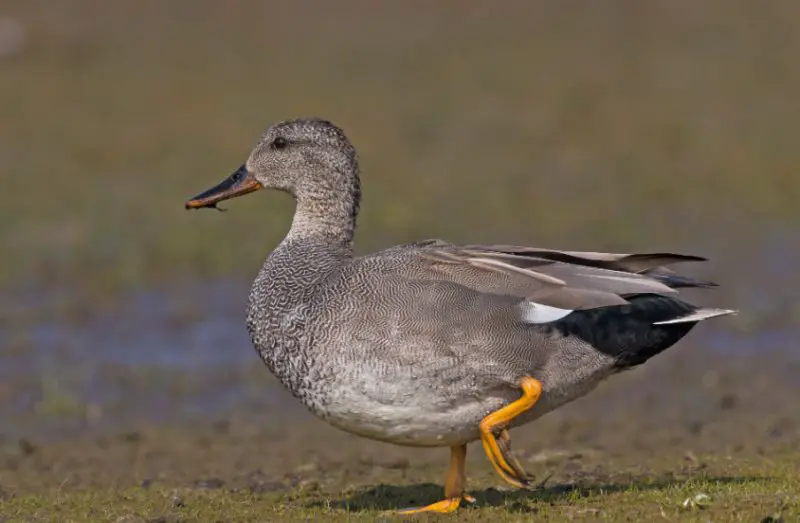
Gadwalls are medium-sized dabbling ducks with subtle but elegant plumage. Males exhibit gray-brown bodies with a black rear end and white speculum on the wings, while females are mottled brown with a lighter face. Gadwalls measure about 19 to 23 inches in length with a wingspan of approximately 32 to 36 inches, making them somewhat smaller than mallards.
Gadwalls feed by dabbling or tipping up in shallow water, primarily eating aquatic vegetation and seeds. They are often seen in smaller flocks than other dabblers and are relatively quiet compared to other duck species. Gadwalls nest near water in dense vegetation, with females incubating eggs in concealed nests on the ground.
In Idaho, Gadwalls are common migrants and summer breeders in wetland areas across the state, including marshes, ponds, and reservoirs. They are frequently observed at the Bear River Migratory Bird Refuge and other key waterfowl habitats. Their numbers increase during migration seasons when they gather in large mixed flocks.
Cinnamon Teal (Spatula cyanoptera)

The Cinnamon Teal is a strikingly colored dabbling duck, especially the male, which sports rich reddish-cinnamon plumage over its body with a bright yellow eye and blue-gray bill. Females are mottled brown with a lighter face and duller coloring. These ducks measure around 15 to 18 inches in length with a wingspan near 24 to 27 inches.
Cinnamon Teals favor shallow marshes, ponds, and wet meadows where they feed mainly on seeds and aquatic invertebrates. They are often shy and prefer dense vegetation for cover. Their breeding range is mainly in the western United States, and they display courtship behaviors including head bobbing and wing flicking.
In Idaho, Cinnamon Teals are common summer residents in wetlands across southern and southwestern regions, especially in warmer, low-elevation areas. They arrive in spring and depart by fall, preferring the marshes of the Snake River Plain and other suitable wetland habitats for nesting and foraging.
Pied-billed Grebe (Podilymbus podiceps)

The Pied-billed Grebe is a small, compact waterbird with a distinctive thick, pale bill marked by a black band (the “pied” bill). It has brownish plumage that blends well with marshy environments and measures about 12 to 15 inches long with a wingspan of roughly 20 to 24 inches. Its feet are lobed rather than webbed, aiding in excellent diving and swimming abilities.
Grebes are excellent divers, often disappearing underwater to catch small fish, insects, and crustaceans. They build floating nests anchored to emergent vegetation in marshes and ponds. Their call is a low, mournful series of coos and whistles, especially during the breeding season.
In Idaho, Pied-billed Grebes are common breeders and year-round residents in many freshwater wetlands, including ponds, marshes, and slow-moving rivers throughout the state. They are particularly abundant in southern Idaho wetlands and can often be seen quietly diving and resurfacing in calm waters.
Black-billed Magpie (Pica hudsonia)
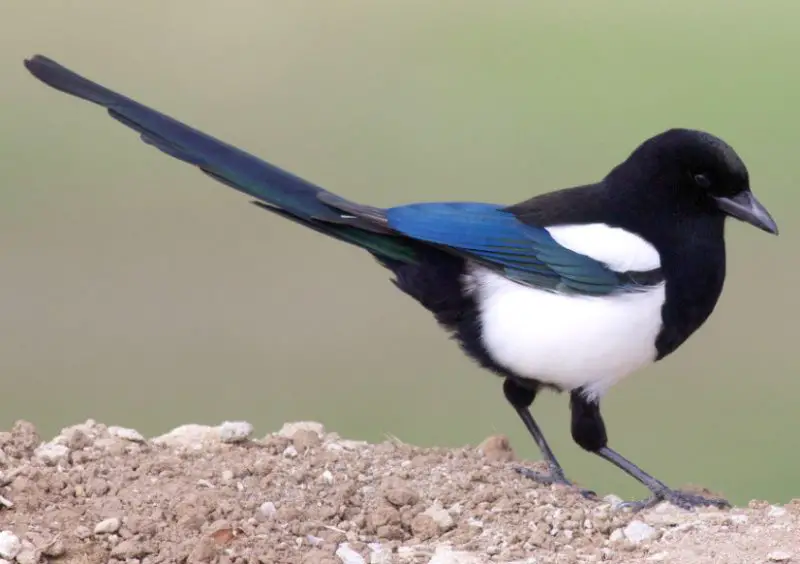
The Black-billed Magpie is a striking bird known for its glossy black and white plumage with iridescent blue-green highlights on its wings and long tail. Measuring about 18 to 24 inches in length, including its long tail, it has a sturdy build and a sharp black bill. This bird is notable for its loud, chattering calls and bold behavior.
Magpies are highly intelligent and social, often seen in pairs or small groups. They forage on the ground for insects, small mammals, seeds, and carrion, and they are known for collecting shiny objects. Their nests are large, dome-shaped structures built from sticks and lined with mud and soft materials.
In Idaho, Black-billed Magpies are common and widespread across a variety of habitats including open woodlands, farmlands, and suburban areas. They are year-round residents throughout the state, often seen perched on fence posts or flying in characteristic low, bounding flight patterns.
Horned Lark (Eremophila alpestris)

The Horned Lark is a small ground-dwelling songbird recognized by its distinctive black “horns” formed by feather tufts, yellow face, and black throat patch. It measures about 6 to 7 inches in length and has a wingspan around 12 to 14 inches. Its brownish and pale underparts provide excellent camouflage in open habitats.
Horned Larks prefer open, treeless areas such as grasslands, fields, and agricultural lands where they forage on seeds and insects by walking and pecking on the ground. Their song is a soft, melodic warble delivered in flight. They build shallow nests on the ground, often hidden by grasses or small shrubs.
In Idaho, Horned Larks are widespread across open plains and sagebrush steppe habitats. They are typically year-round residents in lower elevations but may move slightly seasonally. Their presence is most notable in agricultural areas and large open spaces in southern and central Idaho.
Western Kingbird (Tyrannus verticalis)

The Western Kingbird is a medium-sized flycatcher with a gray head and back, bright yellow belly, and white outer tail feathers visible in flight. Measuring 8 to 9 inches long with a wingspan near 15 inches, this bird is known for its bold, aggressive behavior defending its territory.
Western Kingbirds hunt insects on the wing, often seen perched on wires or fence posts scanning for flying prey. Their vocalizations include sharp “kip” calls and buzzy trills. They nest in open areas such as farmlands, orchards, and suburban edges, building cup-shaped nests in trees or shrubs.
In Idaho, Western Kingbirds are summer residents primarily in the southern and southwestern parts of the state. They arrive in spring to breed and migrate south by early fall. They thrive in open habitats with scattered trees, often near water or agricultural land.
Say’s Phoebe (Sayornis saya)
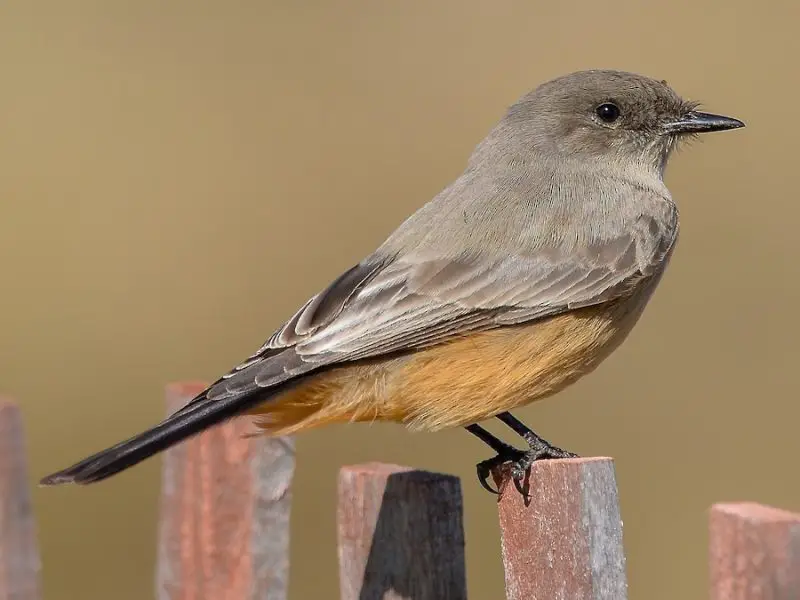
Say’s Phoebe is a slender, medium-sized flycatcher with a gray-brown head and upperparts and a warm peachy-orange belly. It measures about 7 to 8 inches in length with a wingspan near 14 inches. The bird has a characteristic tail-wagging behavior when perched.
This species hunts insects by sallying out from perches, catching prey in midair or gleaning from surfaces. Say’s Phoebe nests on ledges, cliffs, buildings, or under bridges, often using man-made structures. Their song is a soft, whistled series of phrases.
In Idaho, Say’s Phoebe is a common breeder in open, arid habitats such as sagebrush steppe, grasslands, and desert edges. They are found statewide in appropriate habitat during the breeding season and often return to the same nesting sites annually.
Rock Wren (Salpinctes obsoletus)
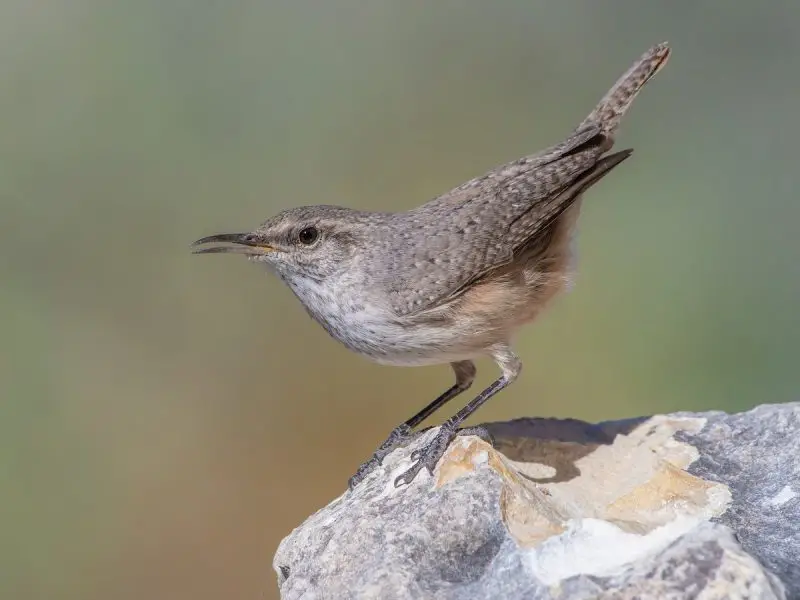
The Rock Wren is a small, active songbird with mottled brown and gray plumage that provides excellent camouflage among rocky habitats. It measures around 5 to 6 inches long with a wingspan of about 8 to 10 inches. It has a slender bill and a habit of flicking its tail frequently.
Rock Wrens forage by hopping and probing crevices for insects and spiders. They are known for their clear, musical songs that carry well across rocky terrain. Nests are built in rock crevices, caves, or abandoned structures, often lined with feathers and grasses.
In Idaho, Rock Wrens are found mainly in the southern and central mountainous and desert regions where rocky outcrops and cliffs provide ideal habitat. They are year-round residents in these dry, rugged areas and are more often heard than seen.
Brewer’s Blackbird (Euphagus cyanocephalus)
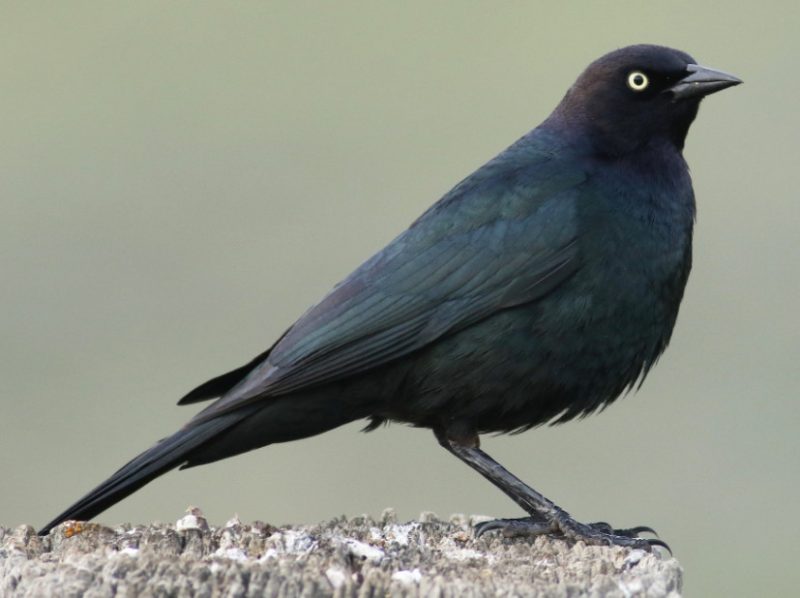
Brewer’s Blackbird is a medium-sized songbird with glossy black plumage in males and dark brown coloration in females. Males often show iridescent purple or green hues on the head and body. They measure approximately 9 to 11 inches in length with a wingspan of 14 to 16 inches.
These birds are highly adaptable and often found in open fields, farmland, and urban areas. They feed on insects, seeds, and grains, frequently foraging on the ground or in shallow water. Brewer’s Blackbirds are social, often forming large flocks outside of the breeding season.
In Idaho, Brewer’s Blackbirds are widespread and common throughout much of the state, especially in agricultural valleys and urban parks. They breed in open habitats with scattered trees and are year-round residents in many parts of Idaho, thriving in both natural and human-altered environments.


